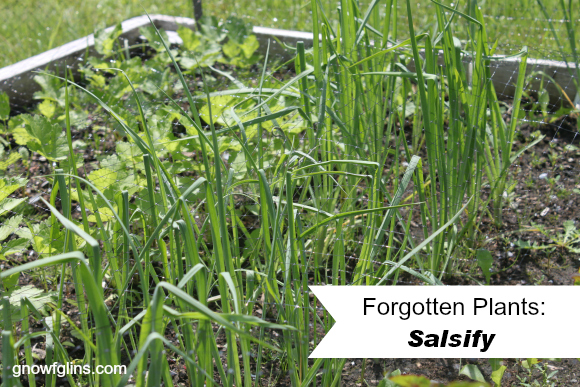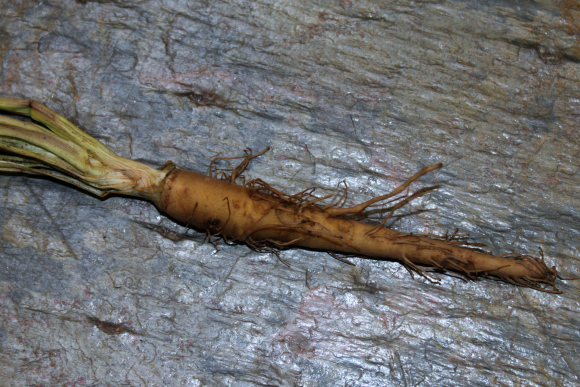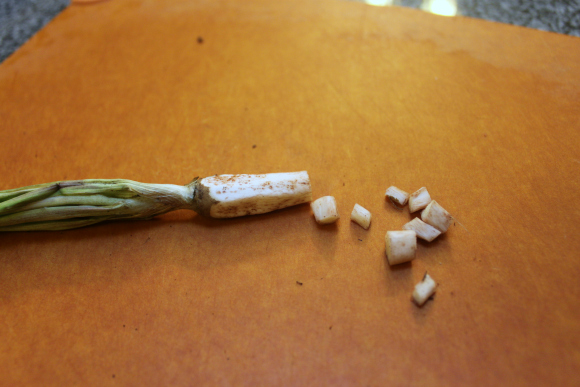
Forgotten Plants: once prolific in the kitchen gardens of our ancestors, but now so rare that the average person might never have even heard of them. Many of these deserve to find space in our gardens again! This is the fourth post in the series.
Salsify. This is where my “forgotten plant” adventure began. It started with a small plot of land, a dream of a simpler time, and The Handy Reliable Cook Book written by Mrs. Jane Warren. The cookbook originally belonged to my great-grandmother, and was published in 1892. I was enchanted with the idea of recreating recipes from a simpler, less-processed era of food production and was determined, in Julie/Julia style, to cook my way through the book.
It didn’t take long for my cookery dreams to come to a halt as I struggled with strange measurements, scant directions, and a call for ingredients that you just don’t find around your local grocery store (a whole ox-head for instance). But the passion for re-discovering some of the lost ingredients and cooking skills of the past remained, and it began in my vegetable garden.
History of Salsify
There are several Salsify recipes in The Handy Reliable Cook Book which led me to believe that this plant must have been a staple in most late 19th century homes. In fact, the history goes much further back, as it was a popular vegetable of the Romans, even making its way into artwork in Pompeii. Cultivation began in the 1500s, and the root reportedly made its way to America in the 1700s. It has also gone by the name “goat’s beard” in it’s wild form, as well as “oyster plant” and “vegetable oyster” in more cultivated varieties.
How to Grow Salsify
Salsify is a root vegetable, growing in a similar manner to carrots and parsnip. The root is long and thin, beige on the outside and white in the middle, and the leaves grow thin and tall, almost like a thick, sturdy grass. Seeds are planted in a sunny location in early spring, as soon as the ground can be worked, and the roots are not harvested until after the first frosts of fall. Harvest continues as long as the ground is warm enough to dig. If left in the ground until spring, the plant will bloom in the second year. This is only my second year growing salsify, but I have found it to be one of those plants you sow in the spring and forget until fall — except perhaps for a little weeding.
Harvesting and Cooking Salsify
The name “oyster plant” was given to Salsify due to a flavour that is reminiscent of oysters, although I have also heard it described as “nutty.” It does not store well out of the ground, so is best harvested and then eaten in short order. The tops are also edible, harvested in early spring and with a flavour that has been described as similar to fiddleheads, asparagus, or chicory. I have also read that the flavour of the tops is better in the second year, should you decide to over-winter your plants.
Although I have not been able to test out any new salsify recipes this year — I had to leave my own salsify crop behind in August, long before it was ready to harvest — I came across several in my research that I am eager to try. The greens can be boiled and served with butter, or added to salads as a raw green. The roots are very versatile, and can be cooked to eat alone, added to soups or stews, thrown in an omelet, scattered around a roast to cook in the juices, sautéed with other vegetables, or formed into fritters. The original wild version of the plant was boiled and then mashed, rather like a potato.
Salsify is high in nutrients, especially vitamins A and C, as well as calcium, iron and phosphorus. It may also help the reduce impurities and toxins in the blood.
If you happen to be lucky enough to have this interesting old plant in your garden, I will leave you with this intriguing recipe for Salsify Tart. It is taken, of course, from the pages of The Handy Reliable Cook Book. I have copied it directly as written and typical to all recipes in the book, it does not have exact amounts, which just adds to the fun, don’t you think?
Salsify Tart Recipe (1892)
Boil the salsify in milk until tender, adding pepper, salt and butter when ready to serve; stir in two or three well beaten eggs, taking care to not let it boil afterward; pour over slices of well toasted bread.
Have you grown or cooked with Salsify? What are your favourite ways to use it?
Sources and further reading: American Heritage Vegetables, Vegetable Info. from A to Z, Mother Earth News:Unusual Vegetables
...without giving up the foods you love or spending all day in the kitchen!

2 free books:
Eat God's Way
Ditch the Standard American Diet, get healthier & happier, and save money on groceries...
We only recommend products and services we wholeheartedly endorse. This post may contain special links through which we earn a small commission if you make a purchase (though your price is the same).




I have not tried it yet but I have seen several recipes in a Mennonite Cookbook that I have. I’ll admit I’m a little nervous about trying it. 🙂
Jenny, my husband is not a vegetable eater, and sceptical of anything new or different, and he actually liked the salsify dish I made last year. So it might be worth trying! 🙂
Is it easy to find organic Salsify seeds? I would love to grow some!
Lindsay – personally I don’t know if “organic” and non-GMO / heirloom mean the same thing, but you can buy non-GMO / heirloom Salsify seeds at http://www.rareseeds.com with Baker Creek Heirloom Seeds. They also have seeds from other plants featured in the Forgotten Plants series.
*I do not work for Baker Creek I just love their products*
Thanks, Julie, for the recommendations. In Canada, I usually purchase from Hope Seeds: http://www.hopeseed.com/
my grandmother (born in 1900) had many herbs in her garden. I learned some of these as a child…I loved having peppery pretty nasturtiums in my salad with dandelion greens and plantain if I wanted. she also had salsify, but as a child I did not like the taste, I did like comfrey tea (now not good for you), and mint, or chamomile tea, in the afternoon with grandma in her best china cups.
Wendy, those are such wonderful memories! I inherited my love of gardening from my grandmother and I have fond memories of what she grew in her garden as well, although her choices were a little more mainstream!
I was brought up in Brittany and we ate salsify all the time, it was grown by most people and sold on the market, we ate it steamed and fried in butter
My mom made salsify several times for us when I was a kid. She called it “oyster plant”. I’m pretty sure she got it at the downtown Farmers Market in York, PA where we lived at the time. I remember her making it like she made her parsley potatoes-basically boiled with butter and herbs. Thanks for the memory! I will have to research and see if we get cold enough here in Florida to grow salsify.
I would like to mention that the variety of salsify I believe you’re referring to is Tragopogon porrifolius, also known as purple salsify.
The salsify many of us in the US are intimately familiar with is Western salsify (T. dubius), and is an invasive weed species.
Both varieties are edible, but T. dubius (as you can imagine from that species name) is not considered so. Having spent many summer hours removing T. dubius from my parents’ farm, the amount of work required to harvest it would far outweigh any enjoyment in eating it. T. porrifolius appears to have a much more compact root system that would be easier to harvest.
In addition to the roots the tender stalks, surrounding leaves, and unopened flower heads of T. dubius are also edible and delicious.
Do you, or anyone know where Salsify seeds can be ordered or purchased? Or any food markets that sell Salsify?
Growing salsify for the first time this year. I found my seeds at Seed Savers Exchange for those of you looking at this post in 2021.